Bestway Acquisition of Co-Operative Pharmacy: A UK Case Study Analysis
VerifiedAdded on 2020/06/03
|92
|36500
|36
Case Study
AI Summary
This case study examines the acquisition of Co-Operative Pharmacy by Bestway, a Pakistani-owned enterprise in the UK. The study provides a literature review that explores ethnic minority businesses, Asian family-owned businesses, and the definition of acquisitions. It delves into the external environment, acquisition process, integration strategies, and leadership styles. The case study also addresses human resource issues, challenges faced during mergers, and the impact of employee factors and management practices. It uses case studies to illustrate success and failure in M&A, and concludes with a summary of key findings. The document also includes an appendix with a questionnaire used for research.
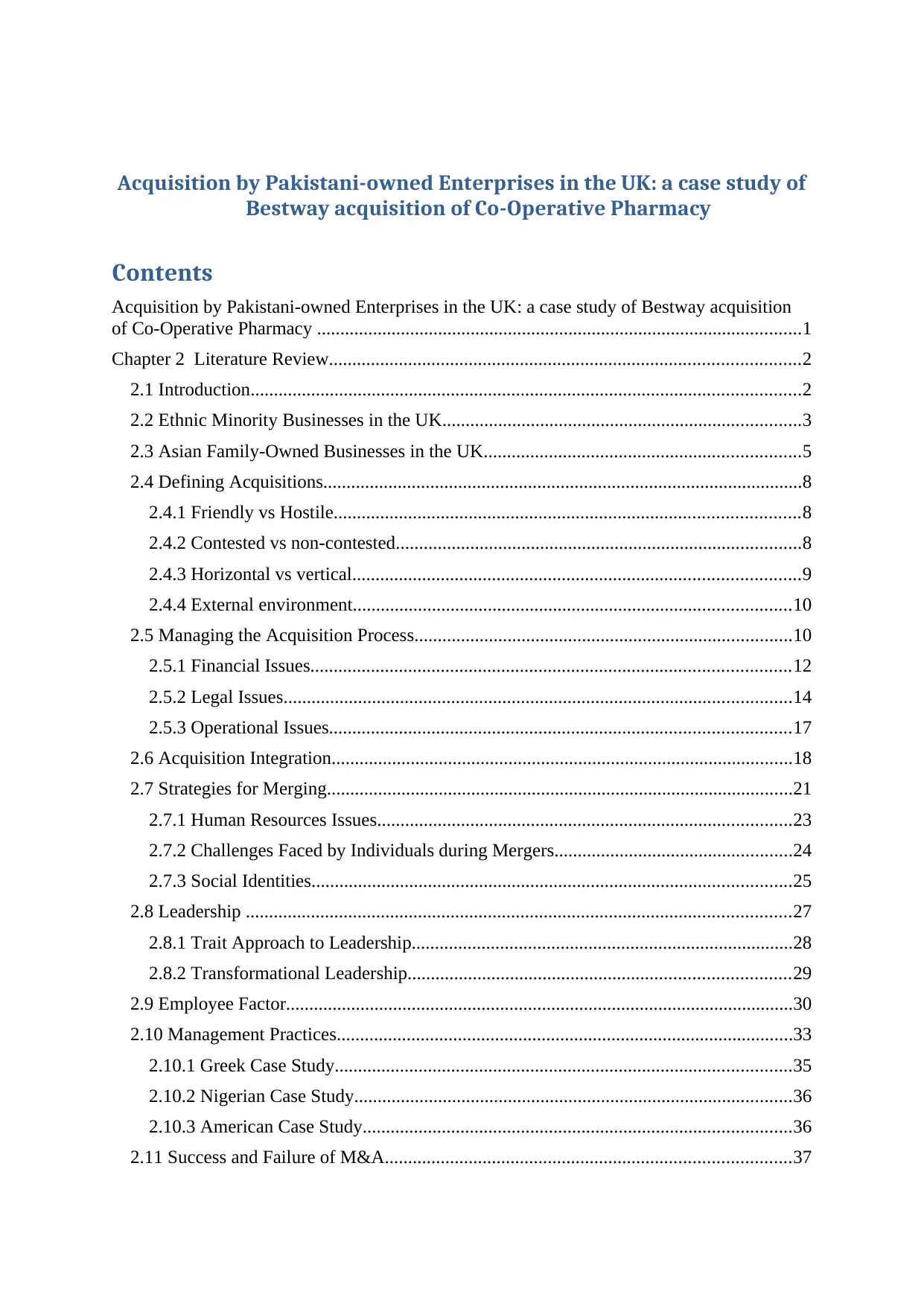
Acquisition by Pakistani-owned Enterprises in the UK: a case study of
Bestway acquisition of Co-Operative Pharmacy
Contents
Acquisition by Pakistani-owned Enterprises in the UK: a case study of Bestway acquisition
of Co-Operative Pharmacy ........................................................................................................1
Chapter 2 Literature Review.....................................................................................................2
2.1 Introduction......................................................................................................................2
2.2 Ethnic Minority Businesses in the UK.............................................................................3
2.3 Asian Family-Owned Businesses in the UK....................................................................5
2.4 Defining Acquisitions.......................................................................................................8
2.4.1 Friendly vs Hostile....................................................................................................8
2.4.2 Contested vs non-contested.......................................................................................8
2.4.3 Horizontal vs vertical................................................................................................9
2.4.4 External environment..............................................................................................10
2.5 Managing the Acquisition Process.................................................................................10
2.5.1 Financial Issues.......................................................................................................12
2.5.2 Legal Issues.............................................................................................................14
2.5.3 Operational Issues...................................................................................................17
2.6 Acquisition Integration...................................................................................................18
2.7 Strategies for Merging....................................................................................................21
2.7.1 Human Resources Issues.........................................................................................23
2.7.2 Challenges Faced by Individuals during Mergers...................................................24
2.7.3 Social Identities.......................................................................................................25
2.8 Leadership .....................................................................................................................27
2.8.1 Trait Approach to Leadership..................................................................................28
2.8.2 Transformational Leadership..................................................................................29
2.9 Employee Factor.............................................................................................................30
2.10 Management Practices..................................................................................................33
2.10.1 Greek Case Study..................................................................................................35
2.10.2 Nigerian Case Study..............................................................................................36
2.10.3 American Case Study............................................................................................36
2.11 Success and Failure of M&A.......................................................................................37
Bestway acquisition of Co-Operative Pharmacy
Contents
Acquisition by Pakistani-owned Enterprises in the UK: a case study of Bestway acquisition
of Co-Operative Pharmacy ........................................................................................................1
Chapter 2 Literature Review.....................................................................................................2
2.1 Introduction......................................................................................................................2
2.2 Ethnic Minority Businesses in the UK.............................................................................3
2.3 Asian Family-Owned Businesses in the UK....................................................................5
2.4 Defining Acquisitions.......................................................................................................8
2.4.1 Friendly vs Hostile....................................................................................................8
2.4.2 Contested vs non-contested.......................................................................................8
2.4.3 Horizontal vs vertical................................................................................................9
2.4.4 External environment..............................................................................................10
2.5 Managing the Acquisition Process.................................................................................10
2.5.1 Financial Issues.......................................................................................................12
2.5.2 Legal Issues.............................................................................................................14
2.5.3 Operational Issues...................................................................................................17
2.6 Acquisition Integration...................................................................................................18
2.7 Strategies for Merging....................................................................................................21
2.7.1 Human Resources Issues.........................................................................................23
2.7.2 Challenges Faced by Individuals during Mergers...................................................24
2.7.3 Social Identities.......................................................................................................25
2.8 Leadership .....................................................................................................................27
2.8.1 Trait Approach to Leadership..................................................................................28
2.8.2 Transformational Leadership..................................................................................29
2.9 Employee Factor.............................................................................................................30
2.10 Management Practices..................................................................................................33
2.10.1 Greek Case Study..................................................................................................35
2.10.2 Nigerian Case Study..............................................................................................36
2.10.3 American Case Study............................................................................................36
2.11 Success and Failure of M&A.......................................................................................37
Paraphrase This Document
Need a fresh take? Get an instant paraphrase of this document with our AI Paraphraser
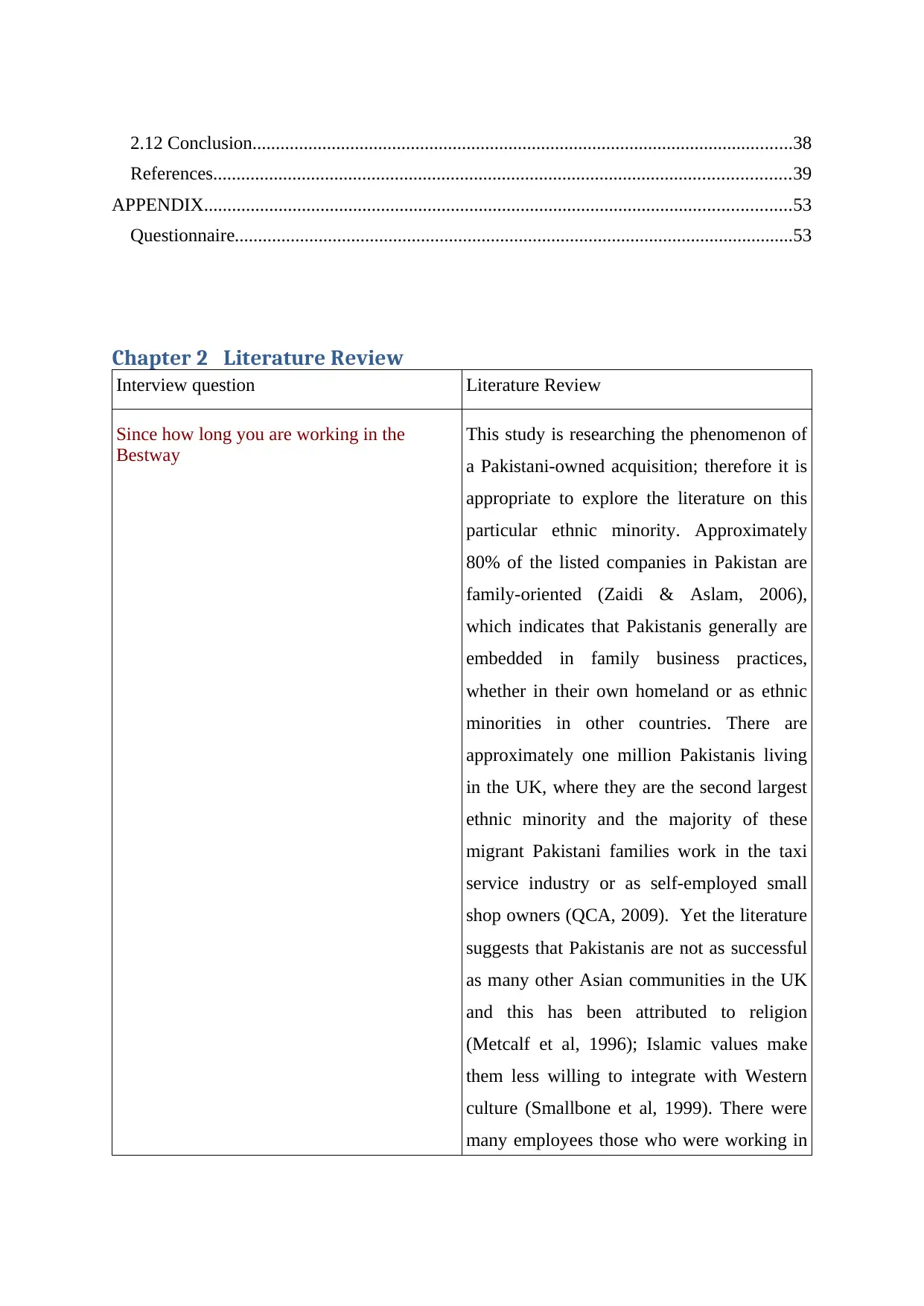
2.12 Conclusion....................................................................................................................38
References............................................................................................................................39
APPENDIX..............................................................................................................................53
Questionnaire........................................................................................................................53
Chapter 2 Literature Review
Interview question Literature Review
Since how long you are working in the
Bestway
This study is researching the phenomenon of
a Pakistani-owned acquisition; therefore it is
appropriate to explore the literature on this
particular ethnic minority. Approximately
80% of the listed companies in Pakistan are
family-oriented (Zaidi & Aslam, 2006),
which indicates that Pakistanis generally are
embedded in family business practices,
whether in their own homeland or as ethnic
minorities in other countries. There are
approximately one million Pakistanis living
in the UK, where they are the second largest
ethnic minority and the majority of these
migrant Pakistani families work in the taxi
service industry or as self-employed small
shop owners (QCA, 2009). Yet the literature
suggests that Pakistanis are not as successful
as many other Asian communities in the UK
and this has been attributed to religion
(Metcalf et al, 1996); Islamic values make
them less willing to integrate with Western
culture (Smallbone et al, 1999). There were
many employees those who were working in
References............................................................................................................................39
APPENDIX..............................................................................................................................53
Questionnaire........................................................................................................................53
Chapter 2 Literature Review
Interview question Literature Review
Since how long you are working in the
Bestway
This study is researching the phenomenon of
a Pakistani-owned acquisition; therefore it is
appropriate to explore the literature on this
particular ethnic minority. Approximately
80% of the listed companies in Pakistan are
family-oriented (Zaidi & Aslam, 2006),
which indicates that Pakistanis generally are
embedded in family business practices,
whether in their own homeland or as ethnic
minorities in other countries. There are
approximately one million Pakistanis living
in the UK, where they are the second largest
ethnic minority and the majority of these
migrant Pakistani families work in the taxi
service industry or as self-employed small
shop owners (QCA, 2009). Yet the literature
suggests that Pakistanis are not as successful
as many other Asian communities in the UK
and this has been attributed to religion
(Metcalf et al, 1996); Islamic values make
them less willing to integrate with Western
culture (Smallbone et al, 1999). There were
many employees those who were working in
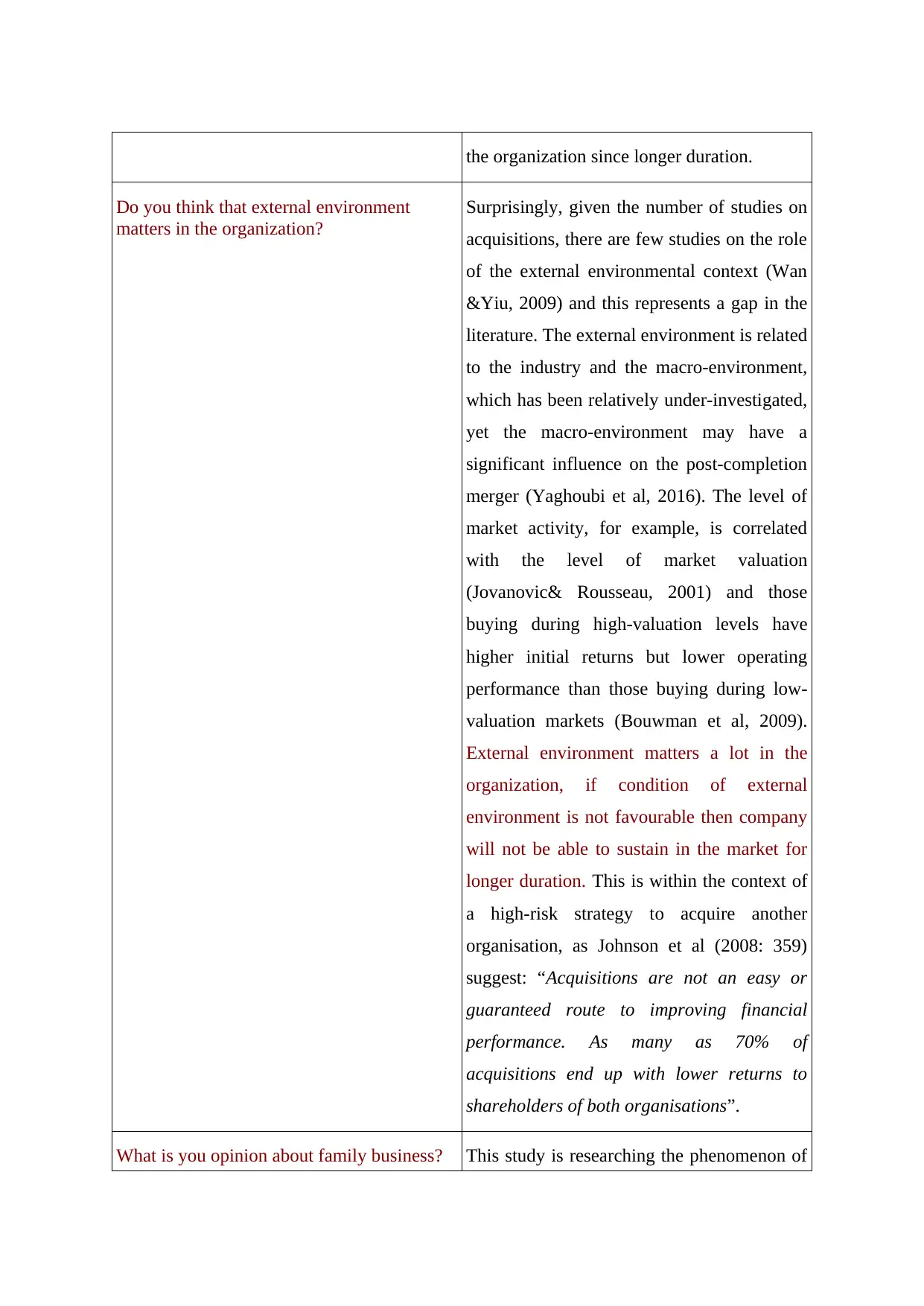
the organization since longer duration.
Do you think that external environment
matters in the organization?
Surprisingly, given the number of studies on
acquisitions, there are few studies on the role
of the external environmental context (Wan
&Yiu, 2009) and this represents a gap in the
literature. The external environment is related
to the industry and the macro-environment,
which has been relatively under-investigated,
yet the macro-environment may have a
significant influence on the post-completion
merger (Yaghoubi et al, 2016). The level of
market activity, for example, is correlated
with the level of market valuation
(Jovanovic& Rousseau, 2001) and those
buying during high-valuation levels have
higher initial returns but lower operating
performance than those buying during low-
valuation markets (Bouwman et al, 2009).
External environment matters a lot in the
organization, if condition of external
environment is not favourable then company
will not be able to sustain in the market for
longer duration. This is within the context of
a high-risk strategy to acquire another
organisation, as Johnson et al (2008: 359)
suggest: “Acquisitions are not an easy or
guaranteed route to improving financial
performance. As many as 70% of
acquisitions end up with lower returns to
shareholders of both organisations”.
What is you opinion about family business? This study is researching the phenomenon of
Do you think that external environment
matters in the organization?
Surprisingly, given the number of studies on
acquisitions, there are few studies on the role
of the external environmental context (Wan
&Yiu, 2009) and this represents a gap in the
literature. The external environment is related
to the industry and the macro-environment,
which has been relatively under-investigated,
yet the macro-environment may have a
significant influence on the post-completion
merger (Yaghoubi et al, 2016). The level of
market activity, for example, is correlated
with the level of market valuation
(Jovanovic& Rousseau, 2001) and those
buying during high-valuation levels have
higher initial returns but lower operating
performance than those buying during low-
valuation markets (Bouwman et al, 2009).
External environment matters a lot in the
organization, if condition of external
environment is not favourable then company
will not be able to sustain in the market for
longer duration. This is within the context of
a high-risk strategy to acquire another
organisation, as Johnson et al (2008: 359)
suggest: “Acquisitions are not an easy or
guaranteed route to improving financial
performance. As many as 70% of
acquisitions end up with lower returns to
shareholders of both organisations”.
What is you opinion about family business? This study is researching the phenomenon of
⊘ This is a preview!⊘
Do you want full access?
Subscribe today to unlock all pages.

Trusted by 1+ million students worldwide
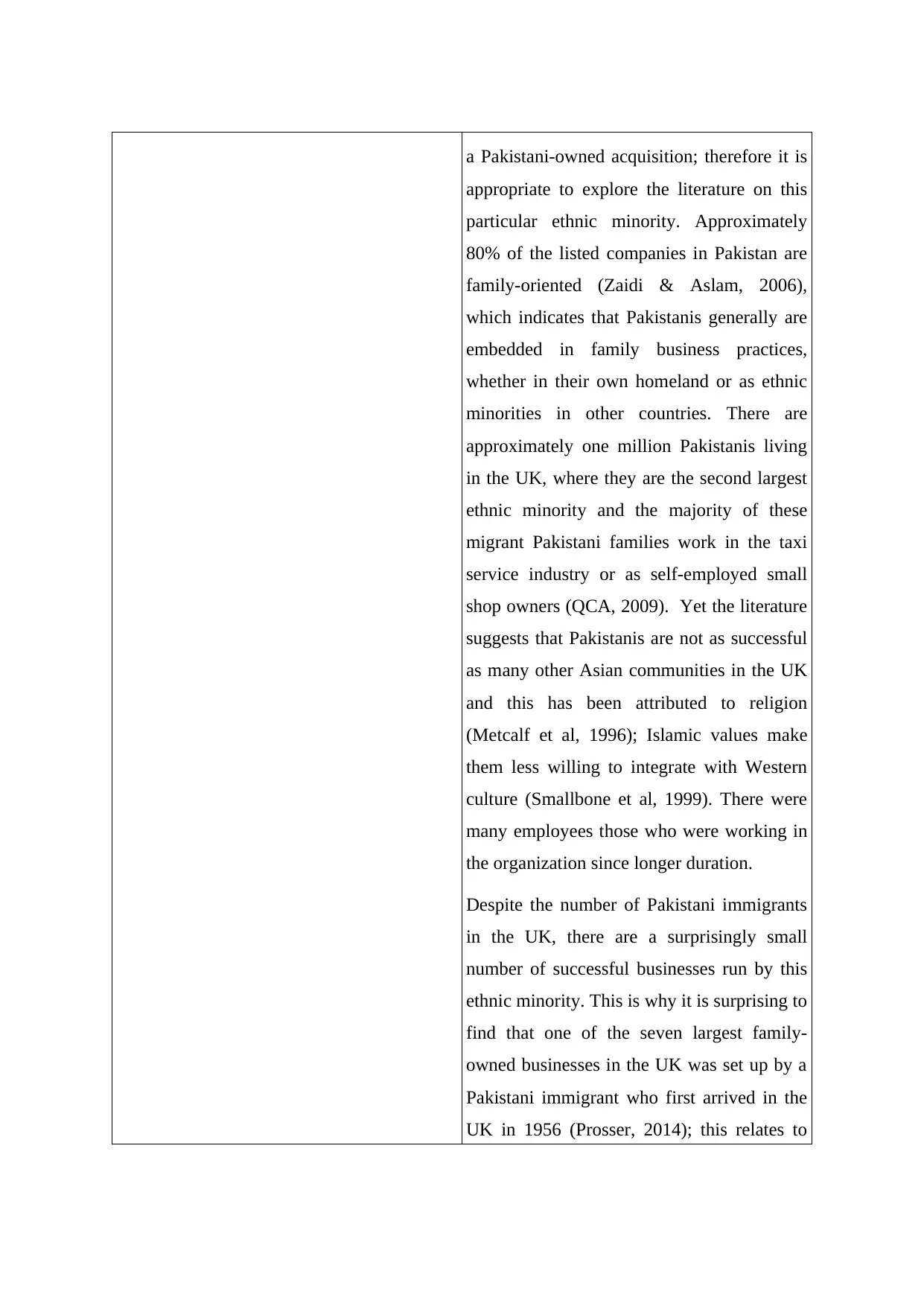
a Pakistani-owned acquisition; therefore it is
appropriate to explore the literature on this
particular ethnic minority. Approximately
80% of the listed companies in Pakistan are
family-oriented (Zaidi & Aslam, 2006),
which indicates that Pakistanis generally are
embedded in family business practices,
whether in their own homeland or as ethnic
minorities in other countries. There are
approximately one million Pakistanis living
in the UK, where they are the second largest
ethnic minority and the majority of these
migrant Pakistani families work in the taxi
service industry or as self-employed small
shop owners (QCA, 2009). Yet the literature
suggests that Pakistanis are not as successful
as many other Asian communities in the UK
and this has been attributed to religion
(Metcalf et al, 1996); Islamic values make
them less willing to integrate with Western
culture (Smallbone et al, 1999). There were
many employees those who were working in
the organization since longer duration.
Despite the number of Pakistani immigrants
in the UK, there are a surprisingly small
number of successful businesses run by this
ethnic minority. This is why it is surprising to
find that one of the seven largest family-
owned businesses in the UK was set up by a
Pakistani immigrant who first arrived in the
UK in 1956 (Prosser, 2014); this relates to
appropriate to explore the literature on this
particular ethnic minority. Approximately
80% of the listed companies in Pakistan are
family-oriented (Zaidi & Aslam, 2006),
which indicates that Pakistanis generally are
embedded in family business practices,
whether in their own homeland or as ethnic
minorities in other countries. There are
approximately one million Pakistanis living
in the UK, where they are the second largest
ethnic minority and the majority of these
migrant Pakistani families work in the taxi
service industry or as self-employed small
shop owners (QCA, 2009). Yet the literature
suggests that Pakistanis are not as successful
as many other Asian communities in the UK
and this has been attributed to religion
(Metcalf et al, 1996); Islamic values make
them less willing to integrate with Western
culture (Smallbone et al, 1999). There were
many employees those who were working in
the organization since longer duration.
Despite the number of Pakistani immigrants
in the UK, there are a surprisingly small
number of successful businesses run by this
ethnic minority. This is why it is surprising to
find that one of the seven largest family-
owned businesses in the UK was set up by a
Pakistani immigrant who first arrived in the
UK in 1956 (Prosser, 2014); this relates to
Paraphrase This Document
Need a fresh take? Get an instant paraphrase of this document with our AI Paraphraser
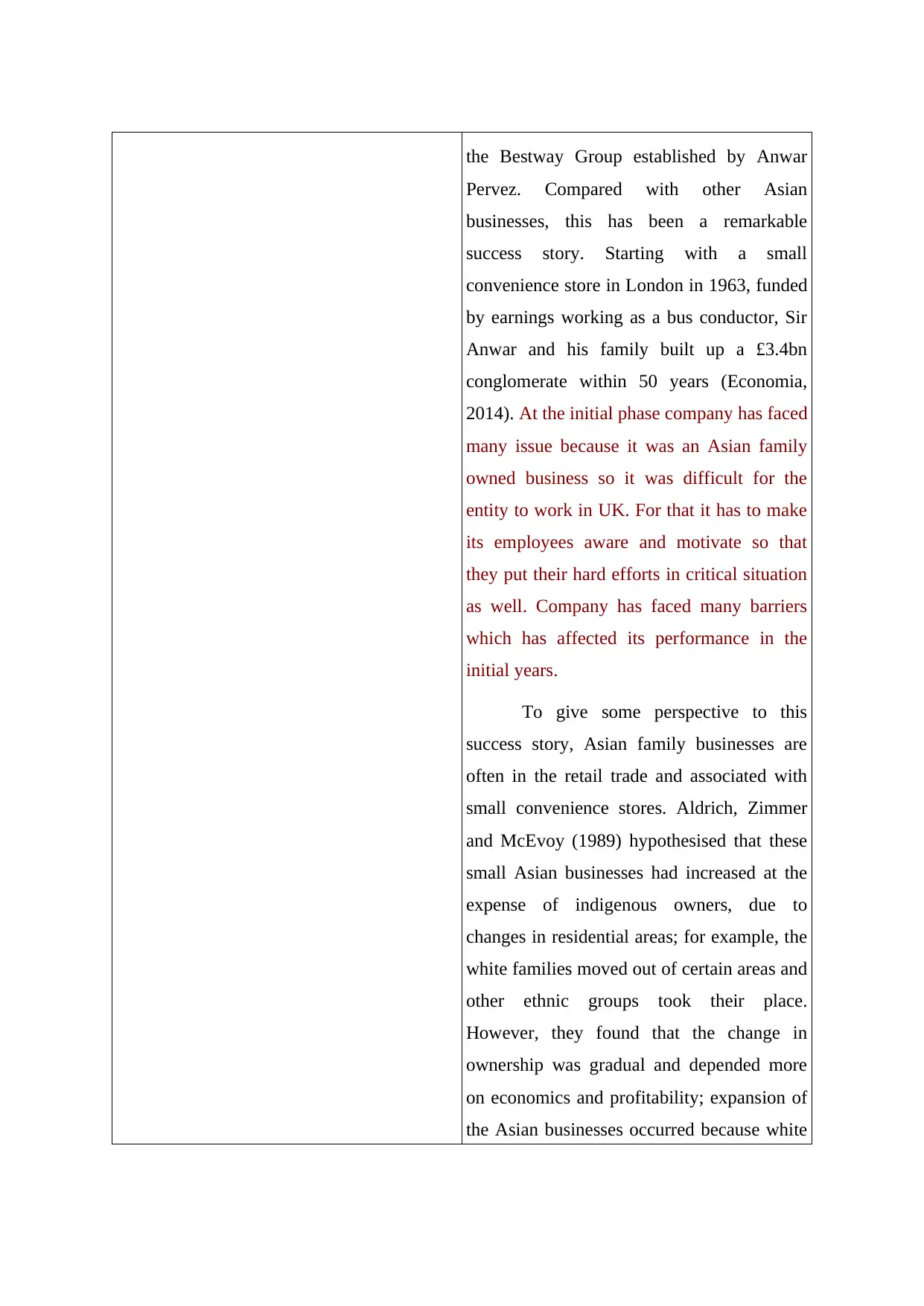
the Bestway Group established by Anwar
Pervez. Compared with other Asian
businesses, this has been a remarkable
success story. Starting with a small
convenience store in London in 1963, funded
by earnings working as a bus conductor, Sir
Anwar and his family built up a £3.4bn
conglomerate within 50 years (Economia,
2014). At the initial phase company has faced
many issue because it was an Asian family
owned business so it was difficult for the
entity to work in UK. For that it has to make
its employees aware and motivate so that
they put their hard efforts in critical situation
as well. Company has faced many barriers
which has affected its performance in the
initial years.
To give some perspective to this
success story, Asian family businesses are
often in the retail trade and associated with
small convenience stores. Aldrich, Zimmer
and McEvoy (1989) hypothesised that these
small Asian businesses had increased at the
expense of indigenous owners, due to
changes in residential areas; for example, the
white families moved out of certain areas and
other ethnic groups took their place.
However, they found that the change in
ownership was gradual and depended more
on economics and profitability; expansion of
the Asian businesses occurred because white
Pervez. Compared with other Asian
businesses, this has been a remarkable
success story. Starting with a small
convenience store in London in 1963, funded
by earnings working as a bus conductor, Sir
Anwar and his family built up a £3.4bn
conglomerate within 50 years (Economia,
2014). At the initial phase company has faced
many issue because it was an Asian family
owned business so it was difficult for the
entity to work in UK. For that it has to make
its employees aware and motivate so that
they put their hard efforts in critical situation
as well. Company has faced many barriers
which has affected its performance in the
initial years.
To give some perspective to this
success story, Asian family businesses are
often in the retail trade and associated with
small convenience stores. Aldrich, Zimmer
and McEvoy (1989) hypothesised that these
small Asian businesses had increased at the
expense of indigenous owners, due to
changes in residential areas; for example, the
white families moved out of certain areas and
other ethnic groups took their place.
However, they found that the change in
ownership was gradual and depended more
on economics and profitability; expansion of
the Asian businesses occurred because white
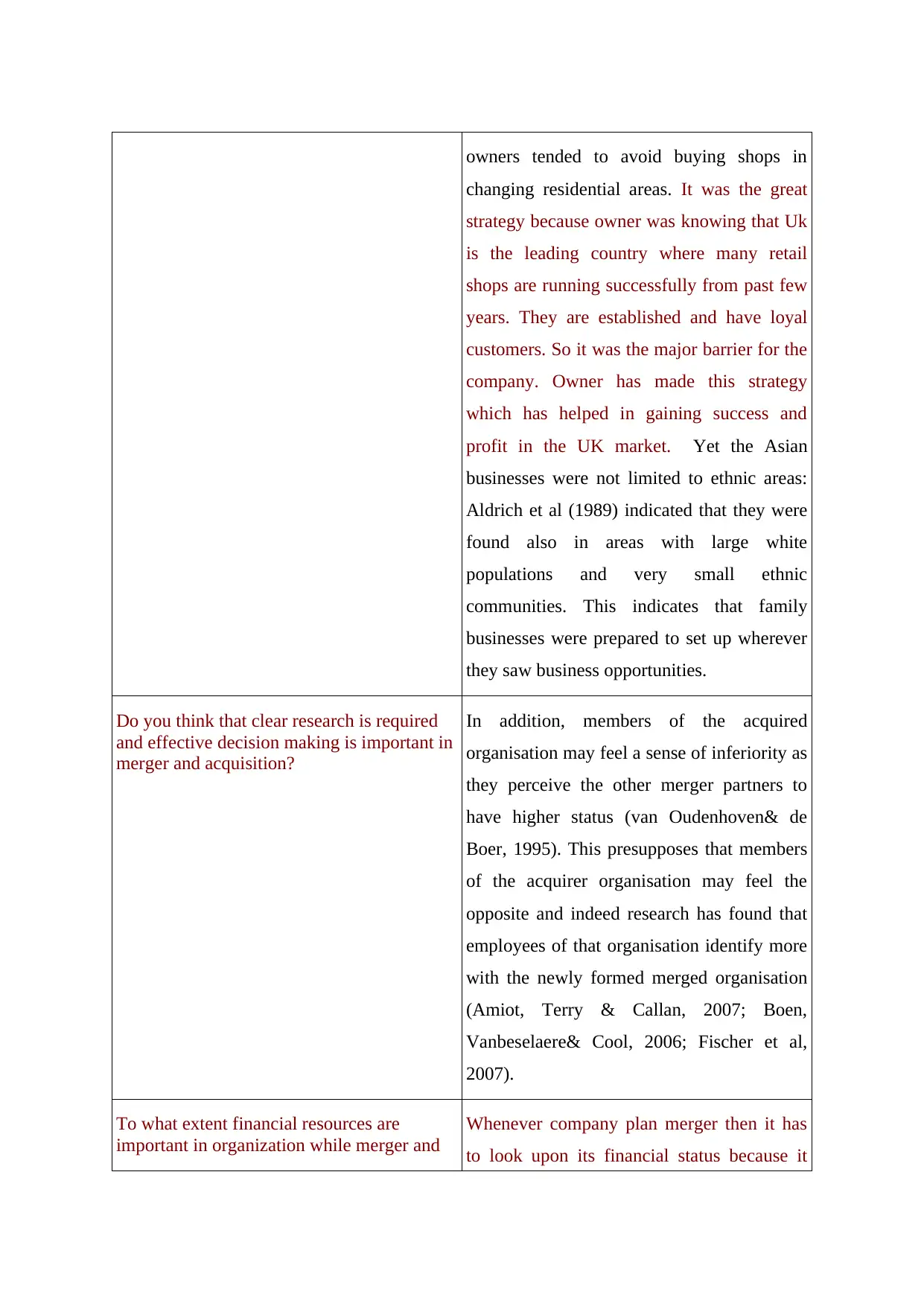
owners tended to avoid buying shops in
changing residential areas. It was the great
strategy because owner was knowing that Uk
is the leading country where many retail
shops are running successfully from past few
years. They are established and have loyal
customers. So it was the major barrier for the
company. Owner has made this strategy
which has helped in gaining success and
profit in the UK market. Yet the Asian
businesses were not limited to ethnic areas:
Aldrich et al (1989) indicated that they were
found also in areas with large white
populations and very small ethnic
communities. This indicates that family
businesses were prepared to set up wherever
they saw business opportunities.
Do you think that clear research is required
and effective decision making is important in
merger and acquisition?
In addition, members of the acquired
organisation may feel a sense of inferiority as
they perceive the other merger partners to
have higher status (van Oudenhoven& de
Boer, 1995). This presupposes that members
of the acquirer organisation may feel the
opposite and indeed research has found that
employees of that organisation identify more
with the newly formed merged organisation
(Amiot, Terry & Callan, 2007; Boen,
Vanbeselaere& Cool, 2006; Fischer et al,
2007).
To what extent financial resources are
important in organization while merger and
Whenever company plan merger then it has
to look upon its financial status because it
changing residential areas. It was the great
strategy because owner was knowing that Uk
is the leading country where many retail
shops are running successfully from past few
years. They are established and have loyal
customers. So it was the major barrier for the
company. Owner has made this strategy
which has helped in gaining success and
profit in the UK market. Yet the Asian
businesses were not limited to ethnic areas:
Aldrich et al (1989) indicated that they were
found also in areas with large white
populations and very small ethnic
communities. This indicates that family
businesses were prepared to set up wherever
they saw business opportunities.
Do you think that clear research is required
and effective decision making is important in
merger and acquisition?
In addition, members of the acquired
organisation may feel a sense of inferiority as
they perceive the other merger partners to
have higher status (van Oudenhoven& de
Boer, 1995). This presupposes that members
of the acquirer organisation may feel the
opposite and indeed research has found that
employees of that organisation identify more
with the newly formed merged organisation
(Amiot, Terry & Callan, 2007; Boen,
Vanbeselaere& Cool, 2006; Fischer et al,
2007).
To what extent financial resources are
important in organization while merger and
Whenever company plan merger then it has
to look upon its financial status because it
⊘ This is a preview!⊘
Do you want full access?
Subscribe today to unlock all pages.

Trusted by 1+ million students worldwide
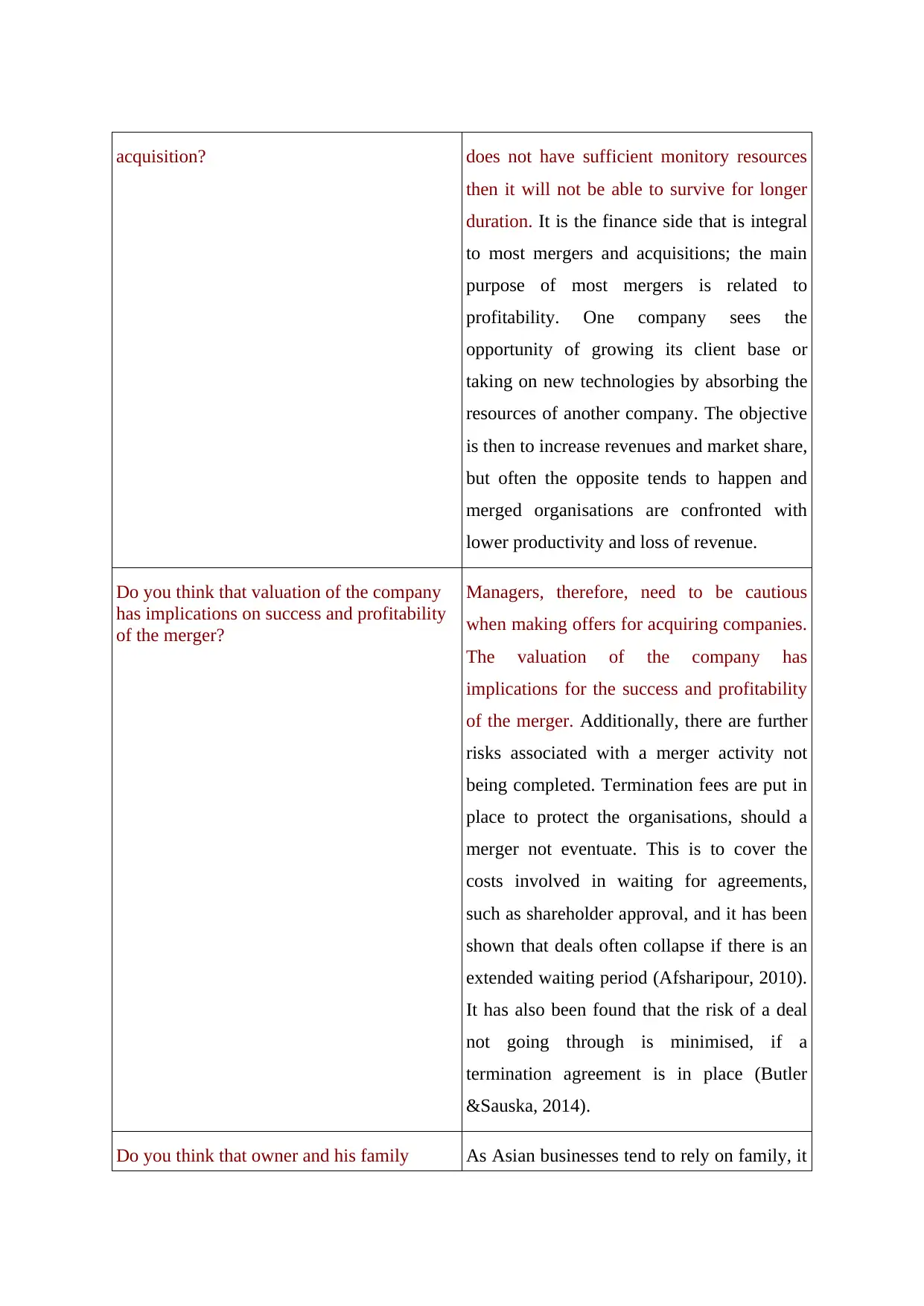
acquisition? does not have sufficient monitory resources
then it will not be able to survive for longer
duration. It is the finance side that is integral
to most mergers and acquisitions; the main
purpose of most mergers is related to
profitability. One company sees the
opportunity of growing its client base or
taking on new technologies by absorbing the
resources of another company. The objective
is then to increase revenues and market share,
but often the opposite tends to happen and
merged organisations are confronted with
lower productivity and loss of revenue.
Do you think that valuation of the company
has implications on success and profitability
of the merger?
Managers, therefore, need to be cautious
when making offers for acquiring companies.
The valuation of the company has
implications for the success and profitability
of the merger. Additionally, there are further
risks associated with a merger activity not
being completed. Termination fees are put in
place to protect the organisations, should a
merger not eventuate. This is to cover the
costs involved in waiting for agreements,
such as shareholder approval, and it has been
shown that deals often collapse if there is an
extended waiting period (Afsharipour, 2010).
It has also been found that the risk of a deal
not going through is minimised, if a
termination agreement is in place (Butler
&Sauska, 2014).
Do you think that owner and his family As Asian businesses tend to rely on family, it
then it will not be able to survive for longer
duration. It is the finance side that is integral
to most mergers and acquisitions; the main
purpose of most mergers is related to
profitability. One company sees the
opportunity of growing its client base or
taking on new technologies by absorbing the
resources of another company. The objective
is then to increase revenues and market share,
but often the opposite tends to happen and
merged organisations are confronted with
lower productivity and loss of revenue.
Do you think that valuation of the company
has implications on success and profitability
of the merger?
Managers, therefore, need to be cautious
when making offers for acquiring companies.
The valuation of the company has
implications for the success and profitability
of the merger. Additionally, there are further
risks associated with a merger activity not
being completed. Termination fees are put in
place to protect the organisations, should a
merger not eventuate. This is to cover the
costs involved in waiting for agreements,
such as shareholder approval, and it has been
shown that deals often collapse if there is an
extended waiting period (Afsharipour, 2010).
It has also been found that the risk of a deal
not going through is minimised, if a
termination agreement is in place (Butler
&Sauska, 2014).
Do you think that owner and his family As Asian businesses tend to rely on family, it
Paraphrase This Document
Need a fresh take? Get an instant paraphrase of this document with our AI Paraphraser
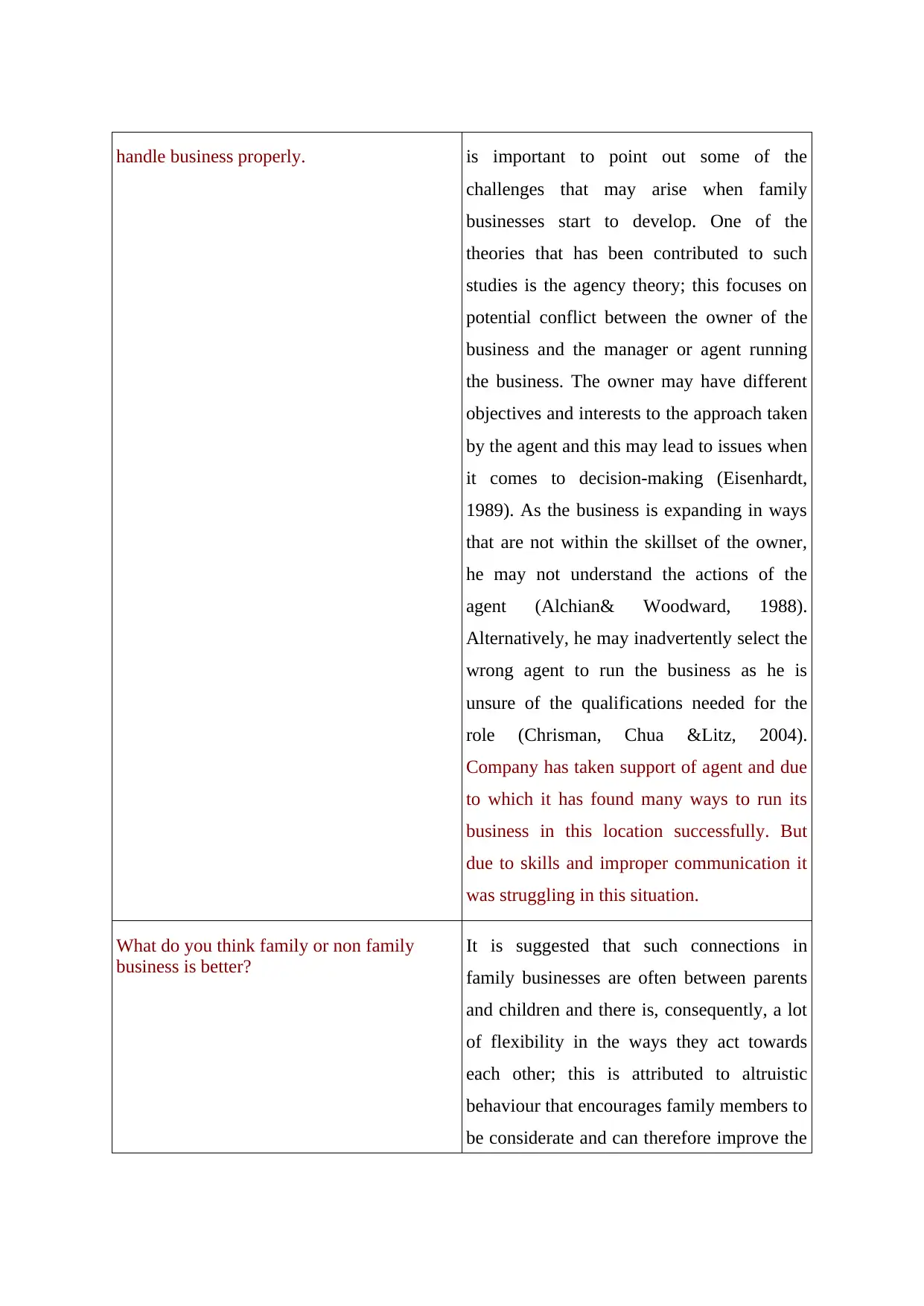
handle business properly. is important to point out some of the
challenges that may arise when family
businesses start to develop. One of the
theories that has been contributed to such
studies is the agency theory; this focuses on
potential conflict between the owner of the
business and the manager or agent running
the business. The owner may have different
objectives and interests to the approach taken
by the agent and this may lead to issues when
it comes to decision-making (Eisenhardt,
1989). As the business is expanding in ways
that are not within the skillset of the owner,
he may not understand the actions of the
agent (Alchian& Woodward, 1988).
Alternatively, he may inadvertently select the
wrong agent to run the business as he is
unsure of the qualifications needed for the
role (Chrisman, Chua &Litz, 2004).
Company has taken support of agent and due
to which it has found many ways to run its
business in this location successfully. But
due to skills and improper communication it
was struggling in this situation.
What do you think family or non family
business is better?
It is suggested that such connections in
family businesses are often between parents
and children and there is, consequently, a lot
of flexibility in the ways they act towards
each other; this is attributed to altruistic
behaviour that encourages family members to
be considerate and can therefore improve the
challenges that may arise when family
businesses start to develop. One of the
theories that has been contributed to such
studies is the agency theory; this focuses on
potential conflict between the owner of the
business and the manager or agent running
the business. The owner may have different
objectives and interests to the approach taken
by the agent and this may lead to issues when
it comes to decision-making (Eisenhardt,
1989). As the business is expanding in ways
that are not within the skillset of the owner,
he may not understand the actions of the
agent (Alchian& Woodward, 1988).
Alternatively, he may inadvertently select the
wrong agent to run the business as he is
unsure of the qualifications needed for the
role (Chrisman, Chua &Litz, 2004).
Company has taken support of agent and due
to which it has found many ways to run its
business in this location successfully. But
due to skills and improper communication it
was struggling in this situation.
What do you think family or non family
business is better?
It is suggested that such connections in
family businesses are often between parents
and children and there is, consequently, a lot
of flexibility in the ways they act towards
each other; this is attributed to altruistic
behaviour that encourages family members to
be considerate and can therefore improve the
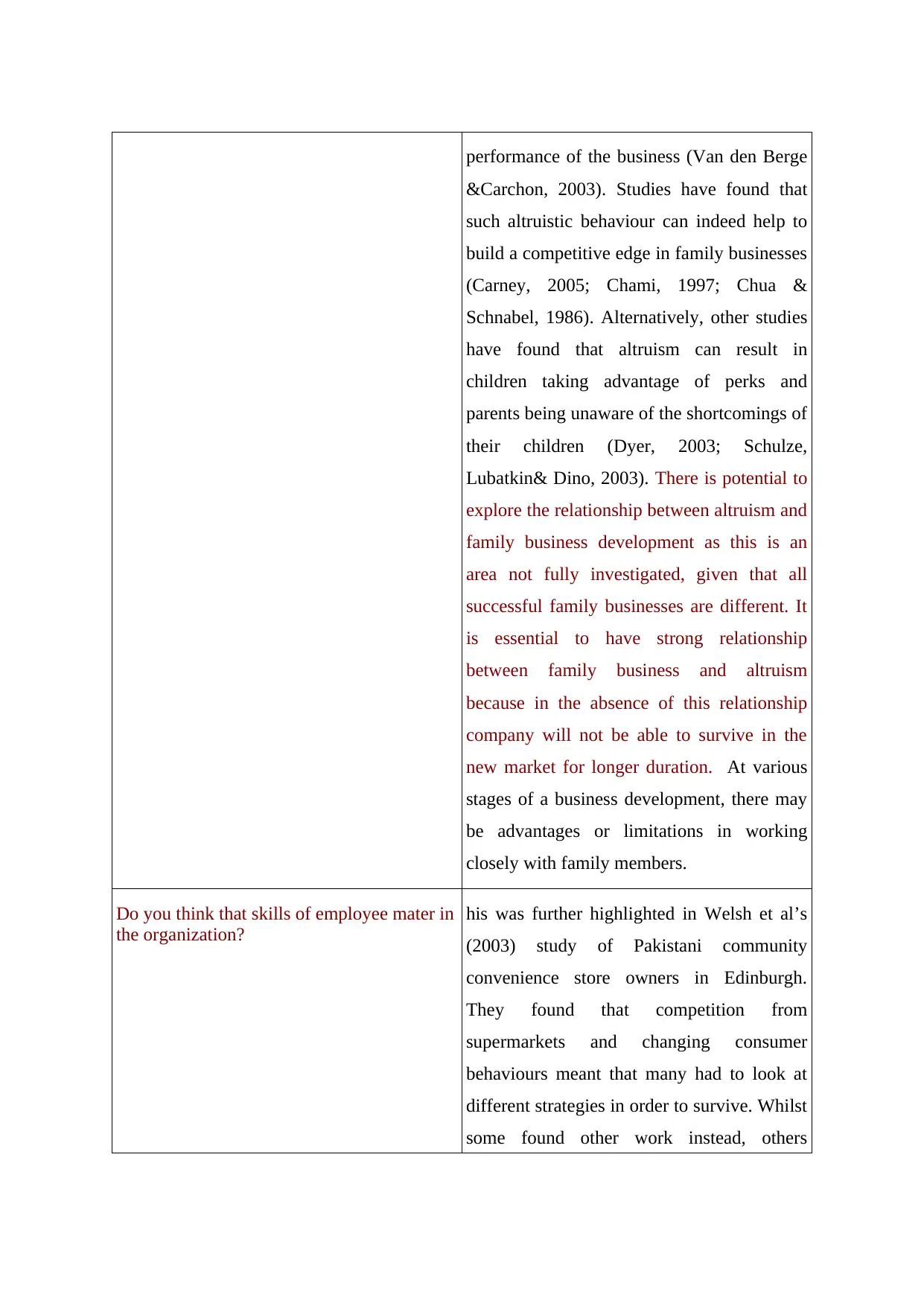
performance of the business (Van den Berge
&Carchon, 2003). Studies have found that
such altruistic behaviour can indeed help to
build a competitive edge in family businesses
(Carney, 2005; Chami, 1997; Chua &
Schnabel, 1986). Alternatively, other studies
have found that altruism can result in
children taking advantage of perks and
parents being unaware of the shortcomings of
their children (Dyer, 2003; Schulze,
Lubatkin& Dino, 2003). There is potential to
explore the relationship between altruism and
family business development as this is an
area not fully investigated, given that all
successful family businesses are different. It
is essential to have strong relationship
between family business and altruism
because in the absence of this relationship
company will not be able to survive in the
new market for longer duration. At various
stages of a business development, there may
be advantages or limitations in working
closely with family members.
Do you think that skills of employee mater in
the organization?
his was further highlighted in Welsh et al’s
(2003) study of Pakistani community
convenience store owners in Edinburgh.
They found that competition from
supermarkets and changing consumer
behaviours meant that many had to look at
different strategies in order to survive. Whilst
some found other work instead, others
&Carchon, 2003). Studies have found that
such altruistic behaviour can indeed help to
build a competitive edge in family businesses
(Carney, 2005; Chami, 1997; Chua &
Schnabel, 1986). Alternatively, other studies
have found that altruism can result in
children taking advantage of perks and
parents being unaware of the shortcomings of
their children (Dyer, 2003; Schulze,
Lubatkin& Dino, 2003). There is potential to
explore the relationship between altruism and
family business development as this is an
area not fully investigated, given that all
successful family businesses are different. It
is essential to have strong relationship
between family business and altruism
because in the absence of this relationship
company will not be able to survive in the
new market for longer duration. At various
stages of a business development, there may
be advantages or limitations in working
closely with family members.
Do you think that skills of employee mater in
the organization?
his was further highlighted in Welsh et al’s
(2003) study of Pakistani community
convenience store owners in Edinburgh.
They found that competition from
supermarkets and changing consumer
behaviours meant that many had to look at
different strategies in order to survive. Whilst
some found other work instead, others
⊘ This is a preview!⊘
Do you want full access?
Subscribe today to unlock all pages.

Trusted by 1+ million students worldwide
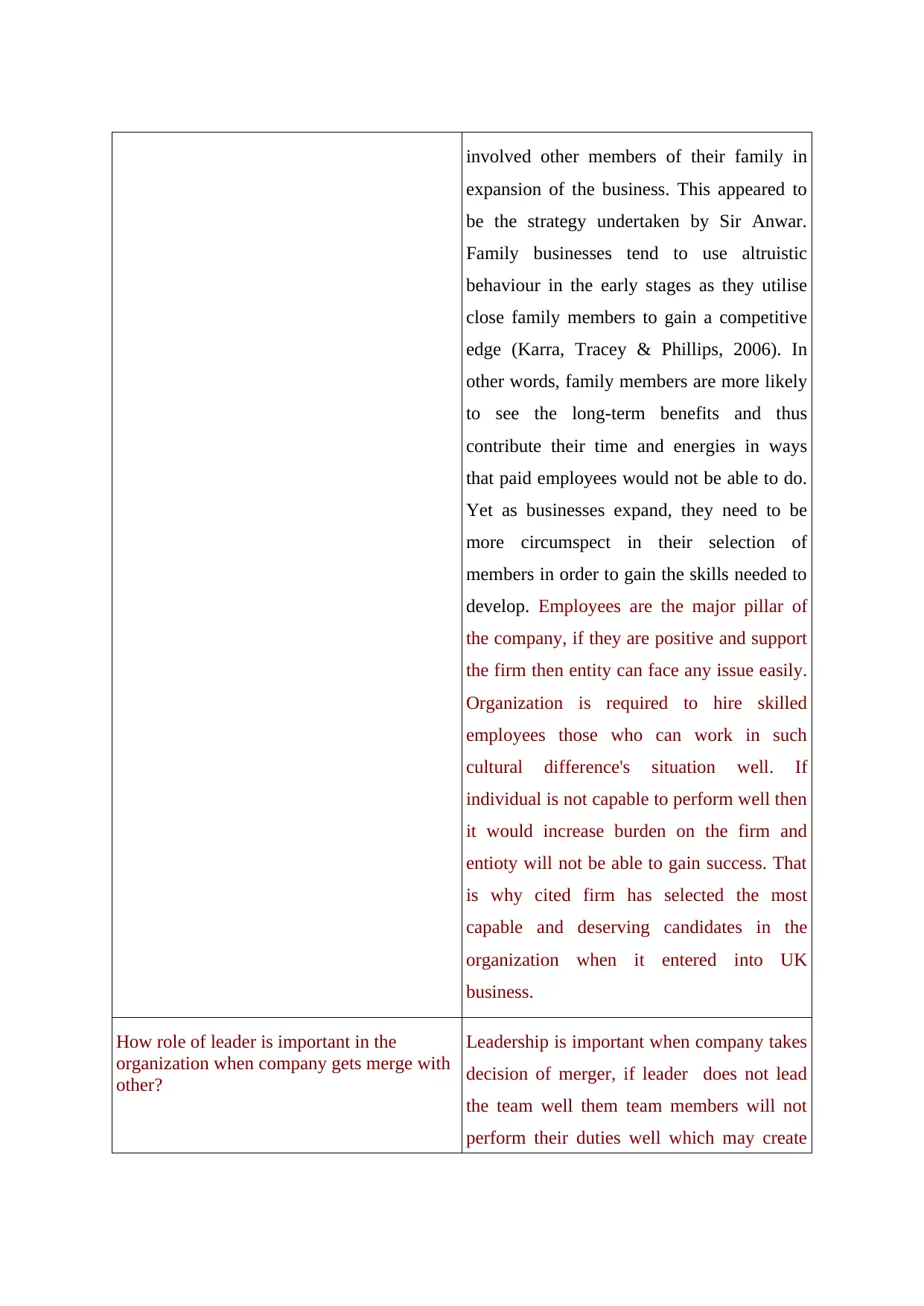
involved other members of their family in
expansion of the business. This appeared to
be the strategy undertaken by Sir Anwar.
Family businesses tend to use altruistic
behaviour in the early stages as they utilise
close family members to gain a competitive
edge (Karra, Tracey & Phillips, 2006). In
other words, family members are more likely
to see the long-term benefits and thus
contribute their time and energies in ways
that paid employees would not be able to do.
Yet as businesses expand, they need to be
more circumspect in their selection of
members in order to gain the skills needed to
develop. Employees are the major pillar of
the company, if they are positive and support
the firm then entity can face any issue easily.
Organization is required to hire skilled
employees those who can work in such
cultural difference's situation well. If
individual is not capable to perform well then
it would increase burden on the firm and
entioty will not be able to gain success. That
is why cited firm has selected the most
capable and deserving candidates in the
organization when it entered into UK
business.
How role of leader is important in the
organization when company gets merge with
other?
Leadership is important when company takes
decision of merger, if leader does not lead
the team well them team members will not
perform their duties well which may create
expansion of the business. This appeared to
be the strategy undertaken by Sir Anwar.
Family businesses tend to use altruistic
behaviour in the early stages as they utilise
close family members to gain a competitive
edge (Karra, Tracey & Phillips, 2006). In
other words, family members are more likely
to see the long-term benefits and thus
contribute their time and energies in ways
that paid employees would not be able to do.
Yet as businesses expand, they need to be
more circumspect in their selection of
members in order to gain the skills needed to
develop. Employees are the major pillar of
the company, if they are positive and support
the firm then entity can face any issue easily.
Organization is required to hire skilled
employees those who can work in such
cultural difference's situation well. If
individual is not capable to perform well then
it would increase burden on the firm and
entioty will not be able to gain success. That
is why cited firm has selected the most
capable and deserving candidates in the
organization when it entered into UK
business.
How role of leader is important in the
organization when company gets merge with
other?
Leadership is important when company takes
decision of merger, if leader does not lead
the team well them team members will not
perform their duties well which may create
Paraphrase This Document
Need a fresh take? Get an instant paraphrase of this document with our AI Paraphraser
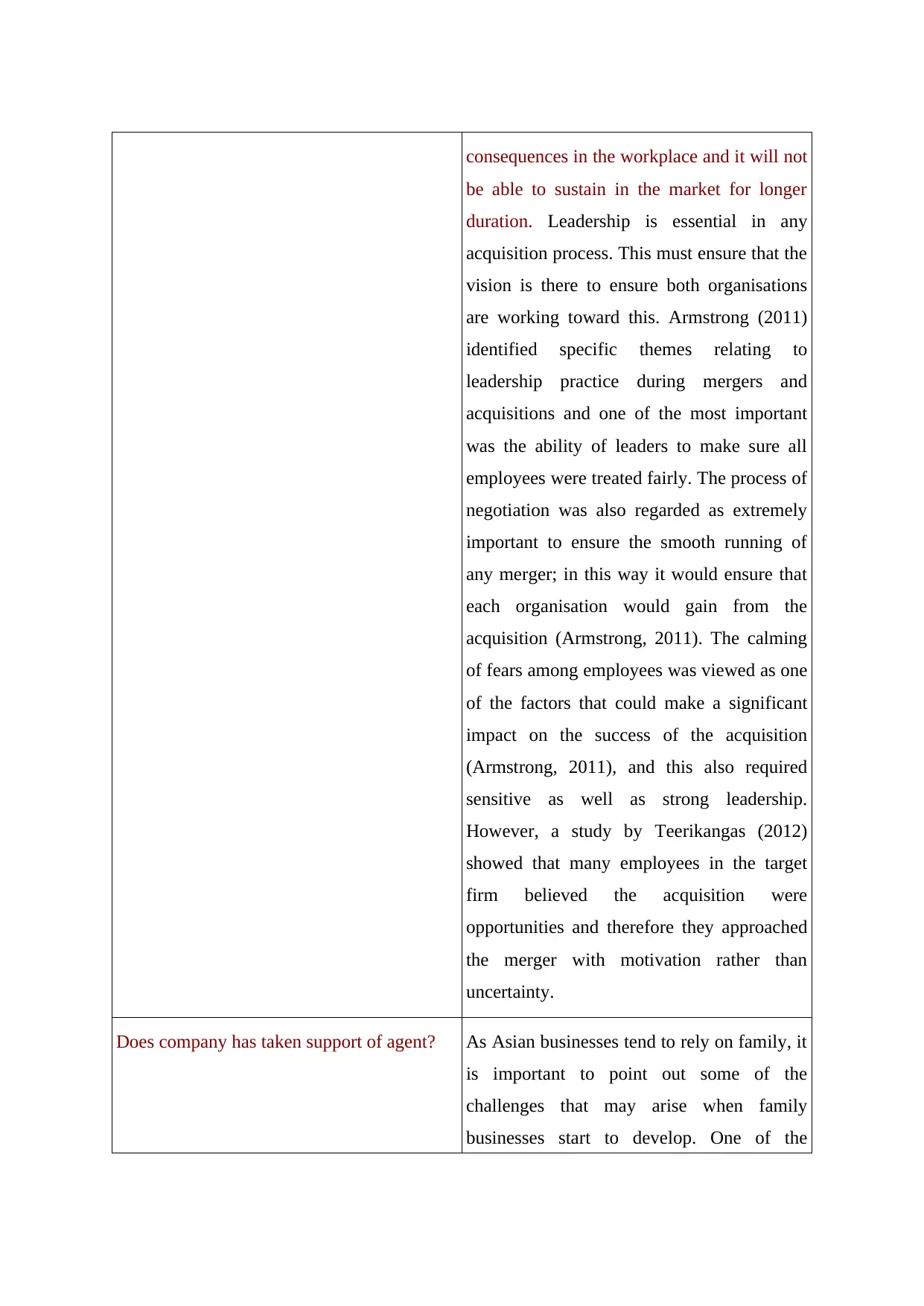
consequences in the workplace and it will not
be able to sustain in the market for longer
duration. Leadership is essential in any
acquisition process. This must ensure that the
vision is there to ensure both organisations
are working toward this. Armstrong (2011)
identified specific themes relating to
leadership practice during mergers and
acquisitions and one of the most important
was the ability of leaders to make sure all
employees were treated fairly. The process of
negotiation was also regarded as extremely
important to ensure the smooth running of
any merger; in this way it would ensure that
each organisation would gain from the
acquisition (Armstrong, 2011). The calming
of fears among employees was viewed as one
of the factors that could make a significant
impact on the success of the acquisition
(Armstrong, 2011), and this also required
sensitive as well as strong leadership.
However, a study by Teerikangas (2012)
showed that many employees in the target
firm believed the acquisition were
opportunities and therefore they approached
the merger with motivation rather than
uncertainty.
Does company has taken support of agent? As Asian businesses tend to rely on family, it
is important to point out some of the
challenges that may arise when family
businesses start to develop. One of the
be able to sustain in the market for longer
duration. Leadership is essential in any
acquisition process. This must ensure that the
vision is there to ensure both organisations
are working toward this. Armstrong (2011)
identified specific themes relating to
leadership practice during mergers and
acquisitions and one of the most important
was the ability of leaders to make sure all
employees were treated fairly. The process of
negotiation was also regarded as extremely
important to ensure the smooth running of
any merger; in this way it would ensure that
each organisation would gain from the
acquisition (Armstrong, 2011). The calming
of fears among employees was viewed as one
of the factors that could make a significant
impact on the success of the acquisition
(Armstrong, 2011), and this also required
sensitive as well as strong leadership.
However, a study by Teerikangas (2012)
showed that many employees in the target
firm believed the acquisition were
opportunities and therefore they approached
the merger with motivation rather than
uncertainty.
Does company has taken support of agent? As Asian businesses tend to rely on family, it
is important to point out some of the
challenges that may arise when family
businesses start to develop. One of the
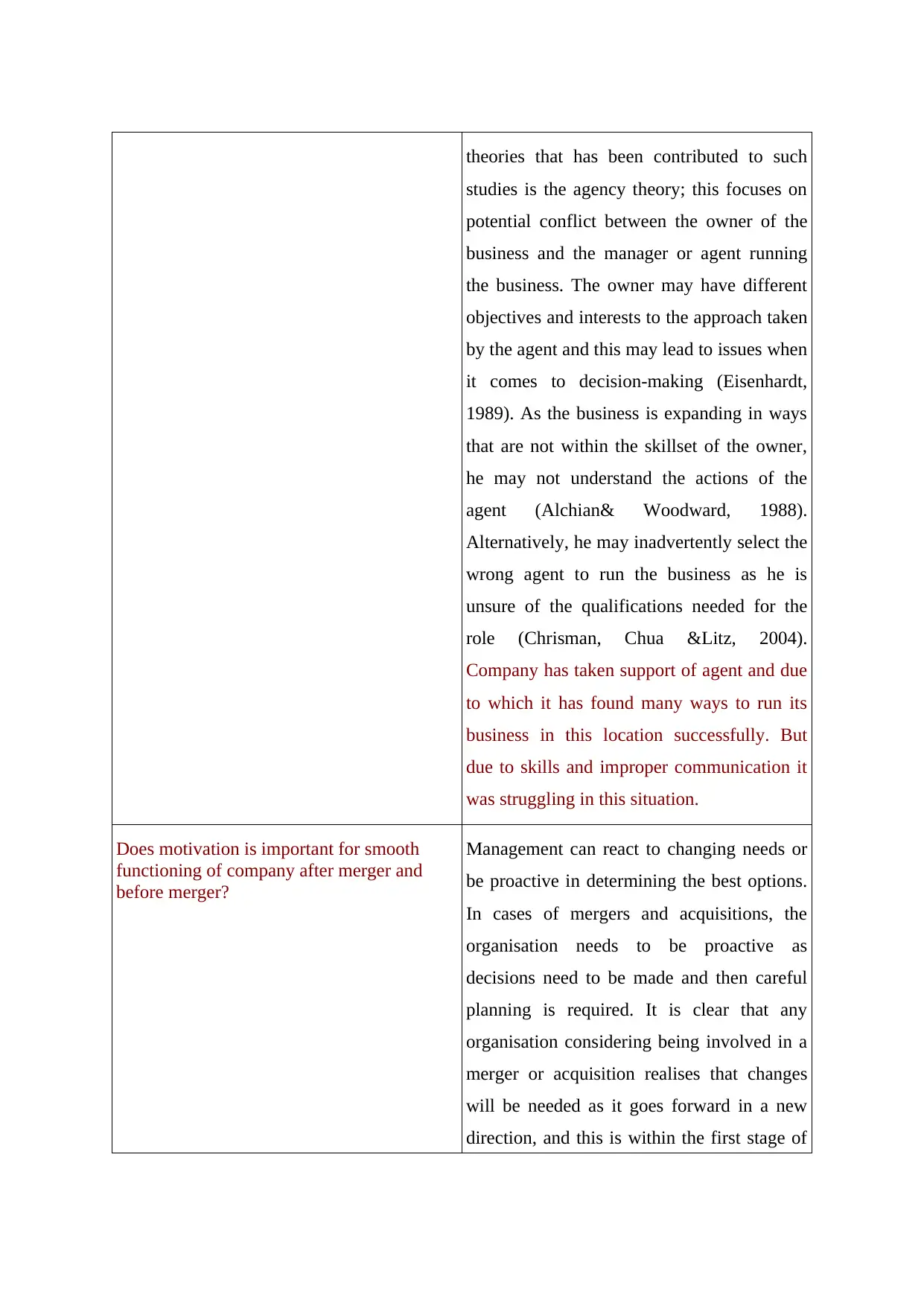
theories that has been contributed to such
studies is the agency theory; this focuses on
potential conflict between the owner of the
business and the manager or agent running
the business. The owner may have different
objectives and interests to the approach taken
by the agent and this may lead to issues when
it comes to decision-making (Eisenhardt,
1989). As the business is expanding in ways
that are not within the skillset of the owner,
he may not understand the actions of the
agent (Alchian& Woodward, 1988).
Alternatively, he may inadvertently select the
wrong agent to run the business as he is
unsure of the qualifications needed for the
role (Chrisman, Chua &Litz, 2004).
Company has taken support of agent and due
to which it has found many ways to run its
business in this location successfully. But
due to skills and improper communication it
was struggling in this situation.
Does motivation is important for smooth
functioning of company after merger and
before merger?
Management can react to changing needs or
be proactive in determining the best options.
In cases of mergers and acquisitions, the
organisation needs to be proactive as
decisions need to be made and then careful
planning is required. It is clear that any
organisation considering being involved in a
merger or acquisition realises that changes
will be needed as it goes forward in a new
direction, and this is within the first stage of
studies is the agency theory; this focuses on
potential conflict between the owner of the
business and the manager or agent running
the business. The owner may have different
objectives and interests to the approach taken
by the agent and this may lead to issues when
it comes to decision-making (Eisenhardt,
1989). As the business is expanding in ways
that are not within the skillset of the owner,
he may not understand the actions of the
agent (Alchian& Woodward, 1988).
Alternatively, he may inadvertently select the
wrong agent to run the business as he is
unsure of the qualifications needed for the
role (Chrisman, Chua &Litz, 2004).
Company has taken support of agent and due
to which it has found many ways to run its
business in this location successfully. But
due to skills and improper communication it
was struggling in this situation.
Does motivation is important for smooth
functioning of company after merger and
before merger?
Management can react to changing needs or
be proactive in determining the best options.
In cases of mergers and acquisitions, the
organisation needs to be proactive as
decisions need to be made and then careful
planning is required. It is clear that any
organisation considering being involved in a
merger or acquisition realises that changes
will be needed as it goes forward in a new
direction, and this is within the first stage of
⊘ This is a preview!⊘
Do you want full access?
Subscribe today to unlock all pages.

Trusted by 1+ million students worldwide
1 out of 92
Your All-in-One AI-Powered Toolkit for Academic Success.
+13062052269
info@desklib.com
Available 24*7 on WhatsApp / Email
![[object Object]](/_next/static/media/star-bottom.7253800d.svg)
Unlock your academic potential
Copyright © 2020–2025 A2Z Services. All Rights Reserved. Developed and managed by ZUCOL.